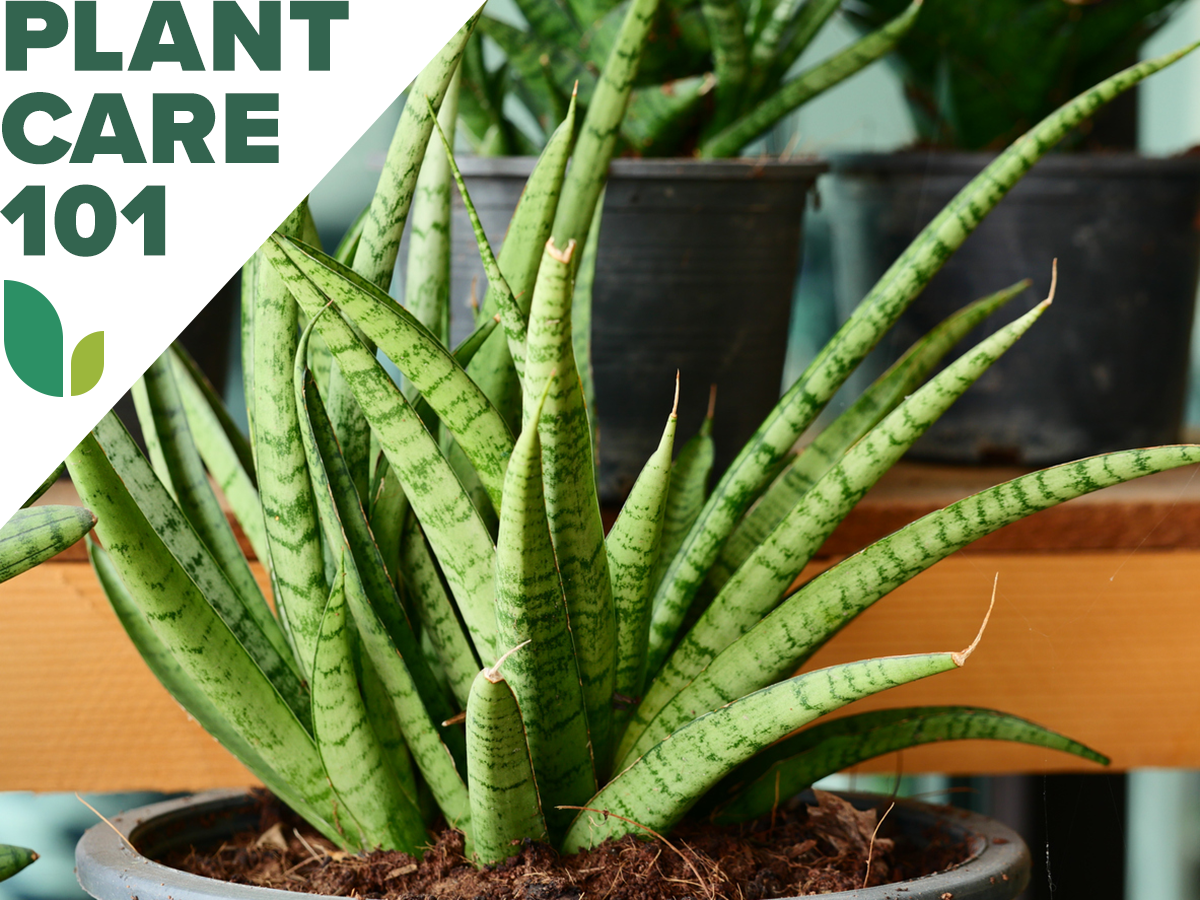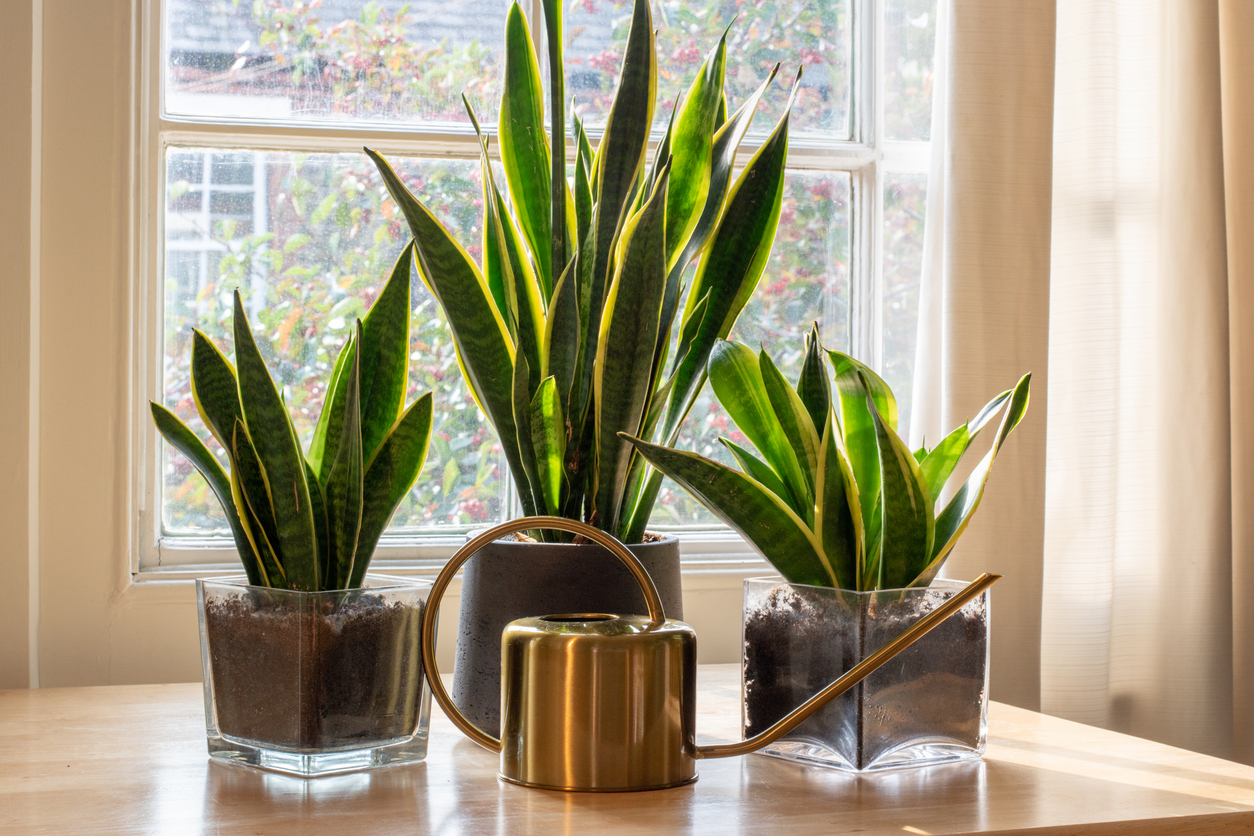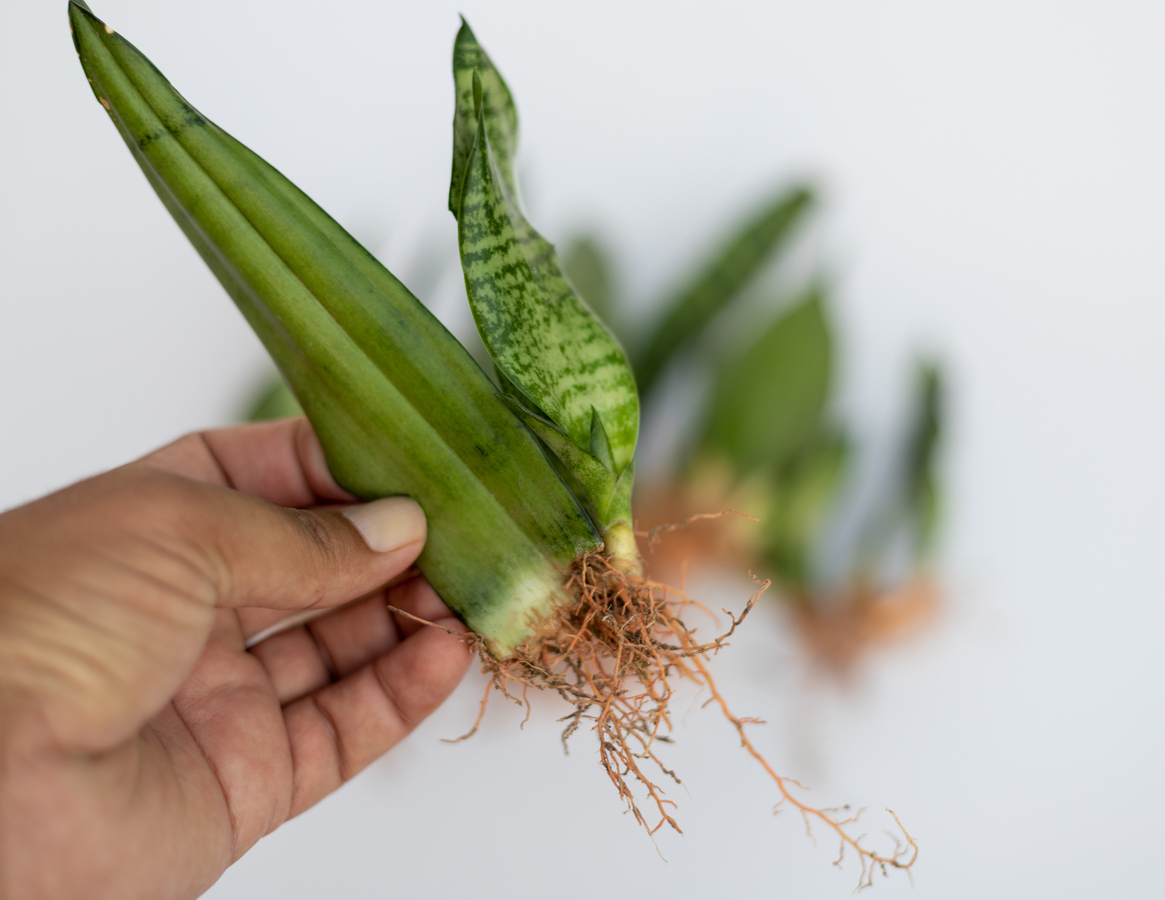

We may earn revenue from the products available on this page and participate in affiliate programs. Learn More ›
Snake plant care is minimal, consisting mostly of infrequent watering, so this succulent is one of the easiest-growing houseplants around. It’s also dubbed “mother-in-law plant” for the sharp tips of its leaves, which are exceptionally striking for such a low-maintenance plant.
Called “snake plant” for its undulating appearance and serpent-like mottling or chevron patterns, Dracaena trifasciata (formerly Sansevieria trifasciata) isn’t creepy or crawly in the slightest. In fact, it’s a perfect houseplant for home decoration. Tall types of snake plants provide a strong vertical accent in a room’s decor, while short varieties are perfect for small pops of color on window sills and shelves.
RELATED: 10 Low-Maintenance Houseplants to Keep Indoor Air Fresh
Snake Plant Care at a Glance
Common name: Snake plant, mother-in-law’s tongue
Scientific name: Dracaena trifasciata, Sansevieria trifasciata
Soil: Cactus and succulent potting soil
Light: Bright, indirect light; morning sun
Water: Low
Food: Cactus and succulent plant food
Temperature and humidity: Average indoor temperatures and humidity
Propagation: Division in spring
Safety: Toxic
Snake Plant Characteristics

Native to tropical West Africa and growing anywhere from 6 inches to 8 feet tall, snake plant rosettes grow from rhizomes. They typically shoot straight up with stiff blade-like foliage in tall cultivars, while shorter “bird’s-nest” snake plant varieties have more relaxed, flaring leaves.
Although mature specimens occasionally produce stalks of spidery and fragrant greenish-white blooms—usually in spring—those flowers are rare on indoor plants. Snake plants are generally grown for their striking foliage, which is usually green with white, cream, or yellow variegation and edging.
Like many houseplants, snake plant benefits include a natural boost to home air filtration; the more snake plants you have, a greater amount of CO2 and air pollutants they’ll absorb via aerobic respiration. They can also be good for mental health, and a snake plant’s simple care regimen is unlikely to be a source of stress.
Types of Snake Plants
- D. trifasciata ‘Golden Hahnii’: Golden bird’s nest snake plant grows up to 8 inches tall with yellow-edged, yellow-variegated green leaves in an upright rosette.
- D. trifasciata ‘Laurentii’: Probably the most popular variegated snake plant, goldband snake plant can reach a height of 4 feet, and its slender green spears are marked with gray-green variegation and yellow edges.
- D. trifasciata ‘Silver Hahnii’: Silver bird’s nest snake plant grows up to about 1 foot tall; its pale green leaves are lightly outlined with dark green and smudged with horizontal green markings.
RELATED: 15 Essentials for Beginner Plant Parents: What Every New Plant Owner Needs
Selecting Soil for Snake Plants

For most gardeners, the best snake plant soil will be fast-draining cactus potting mix. This types of soil helps prevent one of the few things liable to actually kill a snake plant: constant sogginess. If this kind of soil is not available to you, try combining one part cactus soil with one part standard potting soil, since the latter might be too soft and fluffy to hold the taller snake plant cultivars of this plant upright on its own, and it will hold more water.
As for a snake plant pot, a wide terra-cotta or ceramic pot can also help keep your plant’s foliage periscoping, or standing up. Another option is to add a layer of gravel to the bottom of a plastic pot for extra weight and protection against tipping. Just make sure that the container you choose has drainage holes to prevent water from building up around your plant’s roots.
RELATED: 10 Low-Maintenance Houseplants to Keep Indoor Air Fresh
The Right Light

Maintaining the perfect snake plant light requirements boils down to one factor: bright, indirect light. Place yours near a window where direct sunlight won’t quite reach it, or use a sheer curtain to protect a window sill snake plant from the sun’s rays.
If your home can’t quite provide your snake plants with the bright, indirect light they prefer, they also tolerate shadier, low-light conditions. Just be aware that their leaves may lose some of their variegation in dimmer conditions, but less light is unlikely to be a death sentence for these hardy houseplants.
Watering Snake Plants
Snake plant watering requirements, while barebones, do change a bit throughout the year:
- From spring through autumn, water a snake plant when its soil is dry 2 inches down.
- During winter, allow snake plant soil to almost dry out completely before watering it again, about once every 2 weeks.
When watering snake plant, do so thoroughly enough that water drains into its plant saucer. After waiting about 10 minutes for the container to finish draining, discard the excess water from the saucer to prevent soil buildup and brown leaf tips.
Fertilizing Snake Plants

Feed snake plants during spring and summer with a fertilizer intended for cacti and succulents, following the product instructions for application. Alternatively, use a high-phosphorus fertilizer intended for flowering houseplants, mixing it only to half the recommended strength and applying it once monthly from April through September.
Don’t fertilize your snake plant during winter when its growth will have slowed to a slither or stopped completely.
Setting the Temperature and Humidity
Part of what makes how to care for snake plant easy is its tolerance for any temperature between 65 and 90 degrees Fahrenheit. They also don’t mind the low humidity found in most homes.
Since snake plants are hardy only in zones 9 through 12, freezing temperatures can cause them to coil up and die. During winter, keep them away from drafty windows, exterior doors, or any spot that might expose them to frigid air.
Pruning Snake Plants

Snake plants don’t require frequent pruning, but removing dead or damaged foliage can help improve their overall appearance and health. Using a clean knife or pair of scissors, search for leaves that are damaged or discolored and cut them at the base, as close to the soil as possible.
Propagating Snake Plants

Snake plant propagation is (surprise!) not particularly difficult. While they can be grown from cuttings, some types of snake plants are chimeras and won’t retain the coloring of the parent plant from which they were cut.
Thankfully, snake plants produce offspring, or pups, beside them in the pot. This means you can make new plants via division by detaching pups from a parent plant. Here’s a rundown on how to propagate snake plant:
- Remove the plant from the container, rinsing off any soil clinging to its roots.
- Before cutting, make sure the target pup’s L-shaped rhizome already has its own roots and beginning leaves.
- Use a sharp, clean blade to cut the rhizome from the mother plant.
- Plant the rhizome in another pot at the same depth at which it grew in the original container.
- Water it well and keep it in moderate light until it heals.
RELATED: 10 Houseplants You Can Propagate the Fastest for an Ever-Expanding Indoor Garden
Safety Considerations
Snake plants contain saponins, natural compounds that are bitter and toxic enough to cause nausea and vomiting if consumed by adults, children, or pets. Eating snake plant foliage isn’t likely to kill humans, but it can be more dangerous to animals. If your pets are prone to nibbling on greenery, keep snake plants well out of their reach or avoid the species altogether.
A full-grown snake plant in a large pot also can be heavy enough to cause injuries if it topples from a table or window sill. For extra safety, be extra conscious about where you place potted snake plants and keep them out of children’s reach, too.
Potential Pests and Diseases
If your snake plant looks unhealthy, look at the leaves’ color and texture. Yellow snake plant leaves usually indicate overwatering, which means its rhizomes might be rotting. Conversely, wrinkly-looking leaves mean a snake plant likely isn’t being watered enough. If the leaves’ variegation has begun to fade, move the plant to a brighter location.
Snake plants are also susceptible to a couple common houseplant pests. If you notice insects that resemble bits of cotton, get rid of mealybugs by dabbing them with a cotton swab dipped in rubbing alcohol. Webbing on snake plant leaves accompanied by tiny specks could be a sign of a spider mite infestation. Spray them with insecticidal soap, following the directions on the container, and repeat the process five days afterward.
RELATED: 15 Snake Plant Varieties for Low-Maintenance Living Decor
FAQs

If you’re looking for a quick answer to anything not covered above, here are some of the most common questions home gardeners have about snake plants.
Q: How do you repot a snake plant?
If a snake plant has outgrown its container, gently remove it from the existing pot and loosen the root ball. Then, lower the freed root ball into a larger pot with fresh soil, cover the roots fully, and water the plant thoroughly.
Q: Can snake plants live outside?
While snake plants are generally grown as houseplants in most climates, they can survive outdoors year round in hardiness zones 9 through 12. Otherwise, snake plants should be grown indoors, especially in areas with cold winters.
Q: Why is my snake plant drooping?
Drooping snake plant leaves are usually caused by overwatering, one of the few things liable to kill a snake plant. However, this symptom can also be due to a lack of light, the plant becoming root bound, too much cold or heat, or an unchecked pest infestation.
Q: Do snake plants flower?
Yes! Although somewhat rare, some snake plant varieties produce white, green, or yellow flowers in spring or summer.
